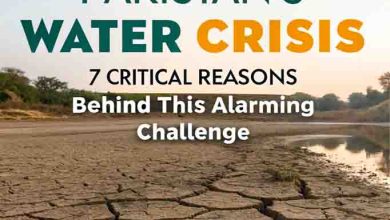Pakistan’s Changing Climate: How Extreme Weather is Reshaping the Nation’s Flood Landscape
Pakistan’s changing climate is reshaping monsoon rains, increasing heatwaves, and causing devastating floods. Learn how rising temperatures and extreme weather are transforming the country’s flood landscape.
Pakistan’s changing climate has reached a critical tipping point. The catastrophic floods across the country tell a story of a shifting monsoon system, rising temperatures, and unprepared infrastructure. Once governed by relatively predictable rainfall patterns, Pakistan now faces erratic and devastating weather events that are rewriting its environmental, social, and economic realities.
Monsoon rains that once nourished crops and replenished rivers now arrive with ferocious intensity and terrifying unpredictability. Communities once considered safe are now flood-prone. The question is no longer if the climate is changing, but how it is devastating Pakistan.
Monsoon Transformation and Heatwave Dynamics
Decades of scientific research and on-ground evidence confirm a fundamental truth: climate change is altering Pakistan’s rainfall and flood systems.
-
The number of rainy days during monsoon season has decreased, yet rainfall intensity has increased dramatically.
-
The monsoon belt has shifted southward, bringing unprecedented rainfall to areas like Sindh and southern Punjab, which were traditionally semi-arid.
-
Since 2010, monsoon belt temperatures have increased by 0.18°C annually.
-
This warming leads to exponential increases in atmospheric moisture. A 1°C rise enables the atmosphere to hold 7% more water vapor, fueling extreme downpours.
Take the April 2025 heatwave: temperatures soared up to 8°C above normal, supercharging the atmosphere for devastating storms that followed. The new climate pattern is a deadly duo: heatwaves followed by floods, increasing both human and infrastructure vulnerability.
Five Devastating Climate Trends Redefining Flood Risk
1. Non-Riverine Flooding
A significant and alarming trend is the rise in non-riverine floods—flooding caused by intense localized rainfall instead of rivers overflowing.
-
Karachi (2020): Over 223mm of rain fell in 24 hours—its worst flood in 90 years.
-
Chakwal (2025): 400mm of rain in 10 hours flooded vast areas without warning.
These floods overwhelm poorly maintained urban drainage systems and encroached water channels. Urban centers like Lahore, Islamabad, and Rawalpindi now face annual urban floods.
Action Needed:
Revising the National Flood Protection Plan IV (2015–2025) to integrate advanced modeling tools, improve early-warning systems, and reinforce urban infrastructure resilience.
2. Cloudbursts and Flash Floods
Cloudbursts—sudden rainfall exceeding 100mm per hour—are occurring more frequently, especially in Azad Kashmir, Gilgit-Baltistan, and Khyber Pakhtunkhwa.
In July 2025, Babusar was devastated by a powerful cloudburst, causing flash floods and landslides. Tragically, misclassification of such events as mere heavy rain delays disaster response and hampers the development of climate insurance policies.
3. Koh-i-Sulaiman Flash Floods
This mountain range bordering Balochistan, Punjab, KP, and Sindh is emerging as a new epicenter for flash floods. In 2022:
-
Flash floods submerged 700,000 people.
-
Over 300,000 acres of crops were lost in D.G. Khan and Rajanpur.
-
Flows in 2024 exceeded 70,000 cusecs, destroying dams and displacing thousands.
Ironically, these areas also offer untapped potential for nature-based water storage and flood management solutions.
4. Salt Range and Barani Areas
The Salt Range and nearby barani (rain-fed) regions are experiencing a climate cocktail: monsoon floods, heatwaves, hailstorms, and even snowfall at higher elevations.
This volatile mix leads to:
-
Topsoil erosion and loss of agricultural productivity.
-
Floods from burst private check dams.
-
Disruption in local ecosystems and economies.
5. Urban Flooding and Infrastructure Collapse
Pakistan’s rapidly expanding cities are dangerously unprepared for climate-induced urban floods:
-
Karachi, Lahore, and Islamabad now face annual flooding disasters.
-
The urban heat island effect intensifies rainfall in cities.
-
Rapid construction blocks natural drainage and water absorption.
The result? Streets turning into rivers, transportation gridlock, business losses, and worsening public health risks.
Why Pakistan Needs a Climate-Smart Flood Strategy
Today, Pakistan’s changing climate is a multi-dimensional crisis. The flood risks are no longer limited to traditional river systems like the Indus. We now face a double flood threat:
-
Pre-monsoon non-riverine floods caused by heatwave-driven cloudbursts.
-
Monsoon riverine floods intensified by upstream snowmelt and rainfall.
Unfortunately, existing policies still focus mostly on riverine floods. This outdated approach must be replaced by climate-smart planning, which includes:
-
Equipping District Disaster Management Authorities (DDMAs) for rapid response.
-
Investing in cloudburst alert systems and satellite forecasting.
-
Expanding nature-based flood defenses in regions like Koh-i-Sulaiman and barani areas.
-
Reengineering urban drainage and water runoff systems.
-
Revising and expanding National Flood Protection Plan IV beyond 2025.
The Urgent Call to Action
Pakistan’s future depends on confronting climate reality with urgency and clarity.
✅ Integrate advanced climate models into national planning.
✅ Fund provincial-level infrastructure for climate-resilient development.
✅ Engage local communities in awareness and preparedness campaigns.
✅ Leverage international climate finance and adapt risk-transfer mechanisms.
External resources like IPCC reports and UNDRR disaster risk guidance should guide national frameworks.
For local insights, Pakistan Meteorological Department and NDMA updates should be incorporated into daily planning cycles.
Conclusion: From Crisis to Climate Resilience
The message is clear: Pakistan’s changing climate is not a distant threat—it’s here, now, and deadly. But it also provides an opportunity for transformation. By moving beyond outdated flood policies and embracing climate-smart, inclusive, and regionally-adapted planning, we can turn a looming disaster into a path of resilience.
This is not just an environmental issue—it’s about national survival, economic stability, and the future of generations to come.
Internal Links:







